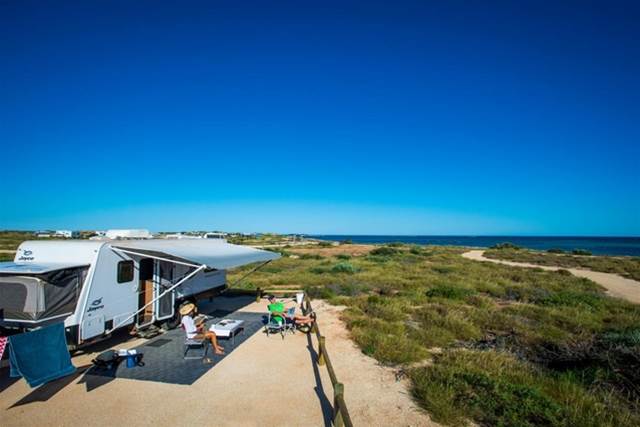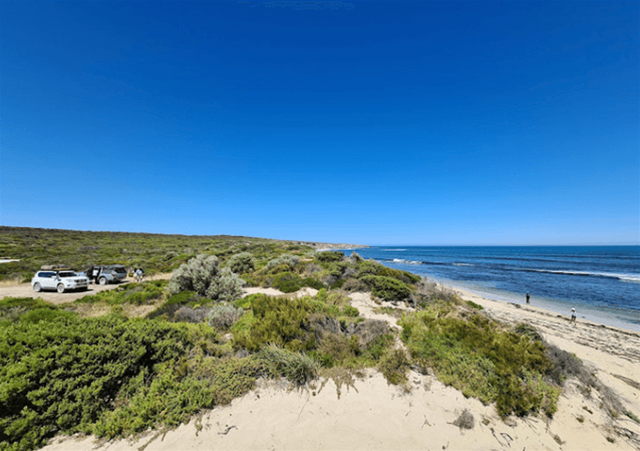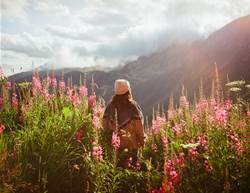Chasing a trip where the walk from your swag to the sand takes less than a minute? These coastal campgrounds deliver exactly that. They’re easy on the budget, big on scenery and close to swims, rock pools and sunrise strolls, ideal for families, first-timers or anyone who wants to swap screen time for sea time.
Each pick keeps logistics simple: bookable sites where needed, straightforward access and a short path to the beach. Before you go, check park alerts, tides and fire bans, pack plenty of water and sun protection, and follow local guidance including respect for Country and wildlife.
Lucky Bay Campground, Cape Le Grand National Park, WA
Snow-white sand, turquoise shallows and the chance of a kangaroo at sunrise make Lucky Bay a show-stopper.
Sites sit in a shallow swale behind the dunes, so it is a short sandy wander to the beach for a morning dip, rock pools or a headland stroll toward Thistle Cove.
Summer brings warm water and afternoon seabreezes, while spring and autumn are milder with wildflowers inland; winter can be blustery but blissfully quiet.
Book online well ahead in school holidays. Facilities are basic with toilets and, at times, seasonal showers, and there are no powered sites, so bring plenty of drinking water, shade and insect repellent, and secure food from wildlife.
Access is usually 2WD to the campground in dry conditions, but beach driving is for 4WD only and always subject to tides and sand softness. Stay on formed tracks, use the designated sites and pack out all rubbish to care for Country.
Osprey Bay Campground, Cape Range National Park (Ningaloo), WA
Here the reef is practically at your door. Low-key beachfront sites face a calm lagoon where you can wade in for a snorkel before the afternoon breeze arrives and, in season, spot turtle tracks on the sand at dawn.
The dry-season months offer warm days and cool nights, with shoulder seasons a good bet for fewer people.
Bookings are essential and peak dates fill fast. Facilities are simple with toilets only and no drinking water or power, so arrive self-sufficient with ample water and sun protection. Access is generally 2WD, though unsealed sections can corrugate.
Enter the water from sandy gaps between coral, watch currents near reef edges, shuffle in the shallows to avoid rays and never stand on coral. Keep to marked tracks, respect nesting areas and take everything you brought back out with you.
Fortescue Bay Campground, Tasman National Park, TAS
Tall eucalypt forest meets a sheltered cove here, so you can wander from your tent to a calm beach swim or step straight onto the start of the Tasman Coastal Trail.
The two camp areas, Banksia and Mill, offer a mix of near-water and more protected, wooded sites, and the bay’s orientation often takes the edge off the wind.
Bookings are required year-round and facilities are limited to essentials such as toilets, so arrive prepared and carry drinking water, warm layers and insect repellent.
Weather turns quickly on the Tasman Peninsula; check park alerts, secure food from wildlife and stick to formed tracks to protect fragile dune and coastal vegetation.
Bay of Fires (Cosy Corner North/South), TAS
This is classic east-coast Tasmania: orange-lichened granite, gin-clear water and free beachfront camping where you can roll out of the tent and onto the sand.
Cosy Corner North and South are first-come camp areas with basic toilets, no bookings and no water, so self-sufficiency is key.
Roads are generally 2WD friendly in good weather but can deteriorate after rain, and wind can pick up along the shore.
Bring ample drinking water, shade and a sturdy rubbish plan, use the provided facilities, avoid driving on soft dunes and leave the site as you found it to keep this stretch pristine.
Johanna Beach Campground, Great Otway National Park, VIC
Wild Southern Ocean views and rolling dunes make Johanna a dramatic stop on the Great Ocean Walk, with a short sandy track linking camp to the surf-pounded beach.
Expect unpowered bush sites and toilets only, with bookings required year-round. The coastline is exposed to strong westerlies, so good pegs and wind breaks help, and conditions can change quickly.
It is a superb place for sunrise strolls and rock-pool explores, but rips are common and the swell can be heavy, so treat swimming with caution and follow local advice.
Bring ample water, sturdy footwear and warm layers even in summer, secure food from wildlife and keep to formed tracks to protect fragile dunes.
Trial Bay Gaol Campground, Arakoon National Park, NSW
Set on a historic headland, this campground fronts a sheltered bay where the water is usually calm and the beach sits just metres from many sites.
Powered and unpowered options are available, bookings are essential in holidays and there are amenities blocks with easy access to the old gaol and coastal walks.
Kangaroos graze around the grounds and goannas are curious, so store food securely and keep camps tidy. The bay is ideal for family swims and sunrise paddles, with kiosks and town services a short drive away.
Check park alerts before arrival, respect the heritage precinct and leave no trace to keep this popular spot pristine.
Noosa North Shore Beach Campground, QLD
Set just behind the dunes opposite Noosa, this campground gives you an easy footpath to a long surf beach and quick access to Cooloola’s sand tracks for 4WD day trips.
Expect a relaxed coastal feel with the sound of the shore as your backdrop and sunrise walks over the dunes before the heat builds. Access is via the Tewantin car ferry, so plan crossings around busy holiday times and arrive with supplies.
Sites include powered and unpowered options plus cabins, and school holidays book out fast. The surf can be strong with rips, so choose calm patches and follow local advice.
If you plan beach driving you will need a permit and careful tide checks, and soft sand demands the right tyre pressures. Store food securely, keep camps tidy and respect any seasonal nesting areas along the beach.
Cable Bay Campground, Dhilba Guuranda–Innes National Park, SA
Tucked by a beautiful swimming bay on the Yorke Peninsula’s rugged tip, this small sandy-floor camp is all about simple pleasures—a quick stroll to clear water, rock platforms to explore at low tide and big sky sunsets over the headlands.
Book online before you go as sites are limited and facilities are basic with no power, so arrive self-sufficient with water and shade. Wind can pick up in the afternoons and nights can feel cool even in summer, so pack layers.
Several other sheltered coves sit a short walk or drive away, making easy options for calmer conditions or a change of scenery.
Roads can include unsealed stretches and wildlife is active at dawn and dusk, so drive cautiously, follow park alerts and leave no trace to keep this coastline pristine.

















